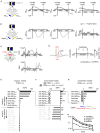Cardiac-Sympathetic Contractility and Neural Alpha-Band Power: Cross-Modal Collaboration during Approach-Avoidance Conflict
- PMID: 39214705
- PMCID: PMC11466073
- DOI: 10.1523/JNEUROSCI.2008-23.2024
Cardiac-Sympathetic Contractility and Neural Alpha-Band Power: Cross-Modal Collaboration during Approach-Avoidance Conflict
Abstract
As evidence mounts that the cardiac-sympathetic nervous system reacts to challenging cognitive settings, we ask if these responses are epiphenomenal companions or if there is evidence suggesting a more intertwined role of this system with cognitive function. Healthy male and female human participants performed an approach-avoidance paradigm, trading off monetary reward for painful electric shock, while we recorded simultaneous electroencephalographic and cardiac-sympathetic signals. Participants were reward sensitive but also experienced approach-avoidance "conflict" when the subjective appeal of the reward was near equivalent to the revulsion of the cost. Drift-diffusion model parameters suggested that participants managed conflict in part by integrating larger volumes of evidence into choices (wider decision boundaries). Late alpha-band (neural) dynamics were consistent with widening decision boundaries serving to combat reward sensitivity and spread attention more fairly to all dimensions of available information. Independently, wider boundaries were also associated with cardiac "contractility" (an index of sympathetically mediated positive inotropy). We also saw evidence of conflict-specific "collaboration" between the neural and cardiac-sympathetic signals. In states of high conflict, the alignment (i.e., product) of alpha dynamics and contractility were associated with a further widening of the boundary, independent of either signal's singular association. Cross-trial coherence analyses provided additional evidence that the autonomic systems controlling cardiac-sympathetics might influence the assessment of information streams during conflict by disrupting or overriding reward processing. We conclude that cardiac-sympathetic control might play a critical role, in collaboration with cognitive processes, during the approach-avoidance conflict in humans.
Keywords: alpha power; approach-avoidance conflict; cardiac-sympathetics; drift-diffusion model; reward sensitivity; sympathetic nervous system.
Copyright © 2024 the authors.
Conflict of interest statement
The authors declare no competing financial interests.
Figures




References
MeSH terms
LinkOut - more resources
Full Text Sources
Research Materials
